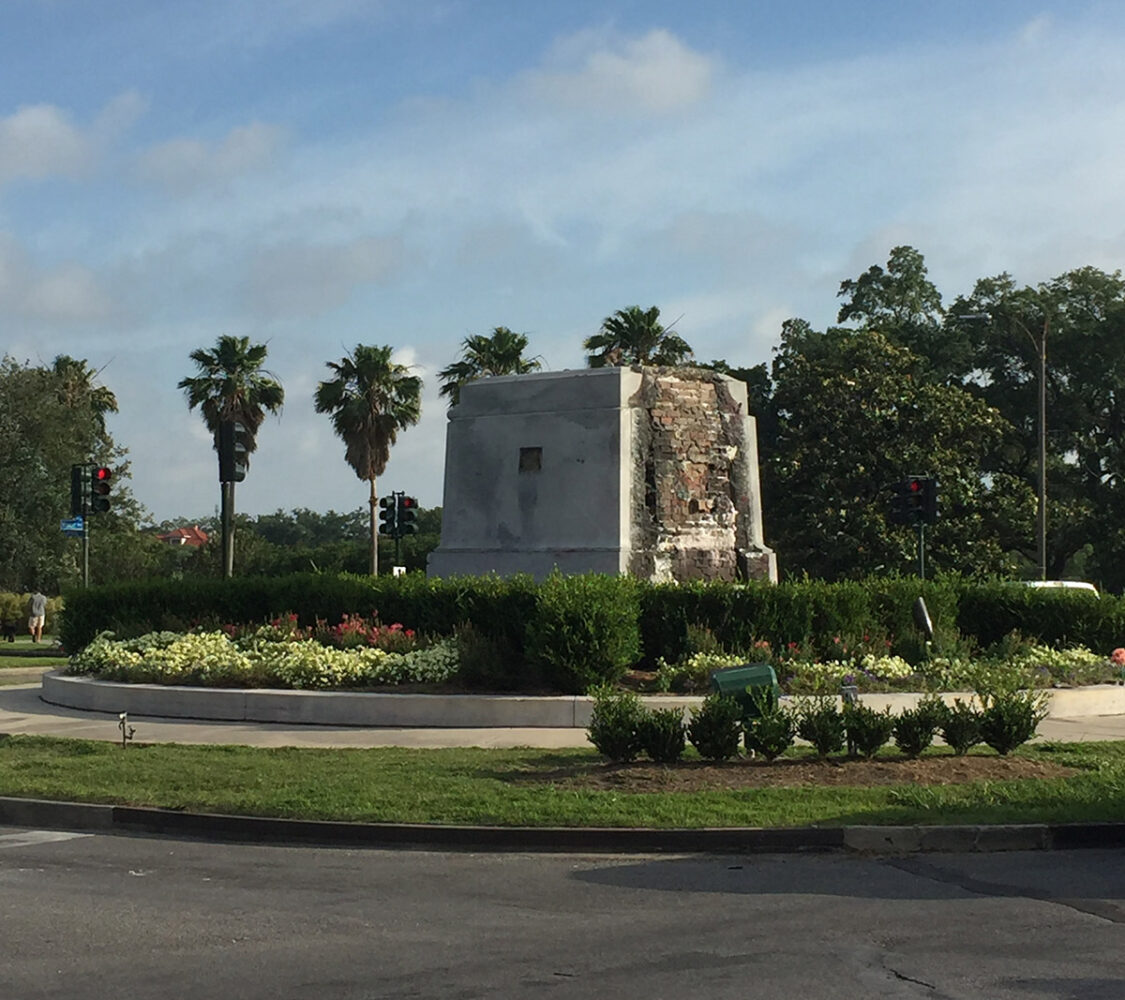Confederate Monument Removal
People have long advocated for the removal of monuments to the Confederacy and white supremacy. State and local governments have removed hundreds of monuments in recent years.

Erin Greenwald
An empty pedestal after removal of the P. G. T. Beauregard monument in New Orleans in May 2017. Photo by Erin Greenwald
According to the Southern Poverty Law Center, since 2015 state and local governments have removed more than 220 Confederate monuments mostly in the states of the former Confederacy. The issue has elicited strong opinions, and while some city governments removed monuments seeing them as a threat to public order, other city governments and state legislatures also passed laws to protect remaining monuments as reminders of a Confederate heritage worth preserving. Some preservationist groups and historians believe the monuments have both aesthetic and historical value and should be left standing with the addition of explanatory plaques. Yet the vocal support of white supremacist groups—neo-fascists, neo-Confederates, neo-Nazis, and Klansmen—to keep the monuments standing has not helped that argument in the court of public opinion. Critics of Confederate monuments have long maintained that the statues and markers symbolize white supremacy and a version of the Civil War that asserts states’ rights was the cause, not slavery.
The Erection of Confederate Monuments in the Nineteenth and Twentieth Centuries
More than seven hundred thousand people died in the Civil War, and the South lost almost 20 percent of white men between the ages of fifteen and forty-five. Confederate veterans and women’s memorial associations dedicated monuments in cemeteries to honor people who had died in the Confederate war effort. Yet most monuments in public spaces went up between 1890 and 1920, when a Lost Cause memory of the war became normalized among large segments of the white population in the South and beyond. This was also the era in which the racial segregation known as Jim Crow became law, and both legal and extra-legal violence against Black populations increased.
According to historian Karen Cox, Black resistance to Confederate symbols goes back to the nineteenth century. The formerly enslaved Black abolitionist Frederick Douglass stated as early as 1871 that “monuments to the Lost Cause will prove monuments of folly.” In Charleston a monument dedicated in 1887 to John C. Calhoun (a South Carolina senator who championed slavery and states’ rights before the Civil War) was such an object of Black contempt that locals scratched and marked it to the point that local officials replaced it with a statue on a higher pedestal. Black scholar W. E. B. Dubois argued by the 1930s that Confederate monuments should be inscribed with the words, “Sacred to the memory of those who fought to perpetuate slavery.” And as Black Americans fought in two world wars in the twentieth century and continued their demands for equal rights, Confederate monuments along with the Lost Cause myth represented a defiant South that resisted any kind of challenge to the racial status quo.
Confederate Monument Removal Nationwide
In the twenty-first century contemporary events spurred the monument removal movement, although activists had advocated since the 1960s for tearing down monuments. On July 17, 2015, white supremacist Dylann Roof, who had posted pictures of himself online with the Confederate flag, killed nine Black members of the Mother Emanuel African Methodist Episcopal Church of Charleston, South Carolina, as they were conducting Bible study. On May 13, 2017, neo-Nazis staged a rally at the Robert E. Lee statue in Charlottesville, Virginia, chanting the Nazi slogan “blood and soil” and “Jews will not replace us” to protest the city council’s decision to take down the statue. The following day counterprotesters and Klansmen clashed, which started a series of events leading to a “Unite the Right” rally on August 2. Twenty-year-old James Alex Fields, a white supremacist, drove his car into a crowd of counterprotestors, killing thirty-two-year-old Heather Heyer and injuring twenty-eight others. The events fueled the takedown of fifty-four monuments related to the Confederacy or white supremacy throughout the United States.
In 2020 the murder of George Floyd by a white police officer in Minneapolis, Minnesota, prompted nation-wide protests led by the Black Lives Matter movement. These protests drew connections between police brutality and symbols of white supremacy, and ultimately led to the removal of ninety-four Confederate monuments that year.
Ground zero was Monument Avenue in Richmond, Virginia, with a row of monuments dedicated to heroes of the Lost Cause. On June 10, 2020, protestors pulled down the statue of Confederate President Jefferson Davis. On July 1 Mayor Levar Stoney announced that he would use his emergency powers to order the removal of monuments on city property, and with noteworthy alacrity, statues of J. E. B. Stuart, Stonewall Jackson, and Matthew Fontaine Maury came down that month. Governor Ralph Northam had announced the removal of the Robert E. Lee monument, which was located on state property, but lawsuits were filed, and it took a ruling by the Virginia Supreme Court to pave the way for its removal on September 8, 2021.
While state legislatures in Alabama, Georgia, Mississippi, North Carolina, South Carolina, and Texas have passed laws to protect the remaining monuments, the dominant practice has been to remove them if they are a threat to the public order. For example, after the George Floyd murder, protestors in Birmingham, Alabama, tried to topple the Confederate Soldiers and Sailors Obelisk in the middle of downtown. Mayor Randall Woodfin defied the Alabama Memorial Preservation Act and ordered the obelisk taken down to preserve public order, opting to take the $25,000 fine. Public officials removed Confederate monuments in Decatur and Kennesaw, Georgia, despite a similar state law. While a committee on Confederate memorials in Atlanta has recommended removing two and placing contextual markers on two others, the state law mandated that all four remain standing along with contextual markers. Nevertheless, after the Lion of the Confederacy statue in Oakland Cemetery was repeatedly vandalized, the city ordered its removal in 2021.
Confederate Monument Removal in Louisiana
Concerns about Confederate symbols occupying public space had been an issue of public debate in New Orleans since at least the early 1990s. Carl Galmon, president of the Louisiana Committee against Apartheid, campaigned vigorously for taking down the Battle of Liberty Place monument and renaming public schools originally named for slaveholders. Malcolm Suber of the African American Liberation League pressured the Orleans Parish School Board to rename forty-one schools memorializing Confederates and slaveholders. By 1997 twenty-two schools were renamed, including those that honored Confederate generals Robert E. Lee and P. G. T. Beauregard as well as president of the Confederacy Jefferson Davis. In 1998, after a renovation of the Lee monument was unveiled to the public, Malcolm Suber, representing the African American History Alliance, wrote to the New Orleans Times Picayune that his group “doesn’t believe there should be any statues honoring any Confederates anywhere in the country.”
In 2014 New Orleans mayor Mitch Landrieu met with musician and composer Wynton Marsalis, who had come to his home city from New York to give a concert. As Marsalis is a native son and a world-renowned artist, Landrieu believed it was important that he serve on the commission for the 2018 tricentennial of the city. Marsalis agreed to serve on the executive committee, but he had a suggestion: take down the statue of Robert E. Lee and rename Lee Circle. The Robert E. Lee monument, dedicated in 1884, stood 104 feet with a sixteen-foot bronze sculpture of Lee atop a sixty-foot pedestal. Public demand for the removal of monuments began to grow. By 2015 a group named Take ‘Em Down NOLA campaigned vociferously for monument removal and against police brutality, often inciting the memory of Alton Sterling of Baton Rouge and others killed by police. However, most monuments were ultimately removed as the result of a political process initiated during Mitch Landrieu’s term as mayor and administered by the New Orleans City Council. By the spring of 2015, three months before the massacre in Charleston, Landrieu worked to remove Confederate monuments to Robert E. Lee, Jefferson Davis, and New Orleans native P. G. T. Beauregard. Also slated for removal was a Reconstruction-era monument celebrating a putsch by the Democratic White League against the Republican government in 1874. Landrieu secured a majority vote by the city council in 2015, and the ordinance survived suits filed by various groups including the Sons of Confederate Veterans. The aforementioned monuments came down in May of 2017. In 2020 the New Orleans City Council established a street renaming commission and began renaming streets, parks, and public places that honored white supremacists.
Confederate monument removal in Louisiana was not confined to New Orleans. In 2017 the Caddo Parish Commission voted to relocate the Confederate monument in front of the Caddo Parish Court House in Shreveport to a battlefield site in Desoto Parish (although there had been discussions going back to 1987). Likewise, the statue of Confederate General Alfred Mouton, which had stood in front of city hall in Lafayette, was removed in 2021 and relocated to a Confederate cemetery in Kentwood.
Conclusion
The public outcry regarding Confederate monuments in southern cities raises questions about what to do about history and public space. The fate of roughly seven hundred remaining monuments hangs in the balance.
